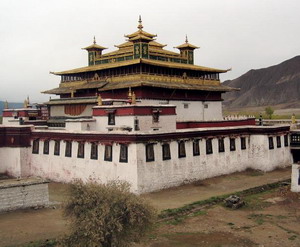
The Samye Monastery or Samye Gompa is the first Buddhist monastery built in Tibet, constructed in approximately 761 AD under the patronage of King Trisong Detsen (Chisong Duosan) of Tibet who sought to revitalize Buddhism, which had declined since its introduction by King Songtsen Gampo in the 7th century. The monastery is located in Dranang (Jialang) county, Shannan Prefecture.
The Samye Monastery is at the foot of Mt. Haibusi, on the north bank of the Yaluzangbu River. Being the 1st monastery, belongs to the Nyingmapa and Sakyapa Sects. The 5th Tobu King Chisong Duosan sent envoys to Kashmir and India to invite famous lamars to teach Buddhism in Tibet. It is said that the monastery was destroyed by fire and was rebuilt three hundred years as the residence of the 6th Dalai Lamar. Finally it was completed by Rating Rimpoche.
The monastery had been combined the Chinese, Tibetan and Indian styles, in the centre of the monastery is a big square 3-storey hall with a floor space of over 8,900 square metres. The first floor is of Tibetan style, the 2nd Chinese and the 3rd Indian. To the direction of the 4 comers of the hall, 4 towers were built respectively in red, white,green and black colours. The Sangsu Monastery is a typical Buddhist building, it deserves its place in the history of architecture.
Samye Monastery is laid out on the shape of a giant mandala, with the main temple representing the legendary Mount Meru in the centre. Other buildings stand at the corners and cardinal points of the main temple, representing continents and other features of the Buddhist universe.
The main temple is full of Tibetan religious art in both mural and statue form, as well as some important relics. Many Tibetan Buddhists come on pilgrimage to Samye, some taking weeks to make the journey.
Storis of the Samye Monastery
According to tradition, the Indian monk Shantarakshita made the first attempt to construct the monastery while promoting his sutra-centric version of Buddhism. Finding the Samye site auspicious he set about to build a structure there. However the building would always collapse after reaching a certain stage. Terrified, the construction workers believed that there was a demon or obstructive thoughtform in a nearby river making trouble.
However, when Shantarakshita's contemporary Padmasambhava arrived from northern India, he was able to subdue the energetic problems obstructing the building of Samye. According to The Fifth Dalai Lama (Pearlman, 2002: p.18), Padmasambhava performed the Vajrakilaya Dance to assist King Trisong Deutsen and Shantarakshita clear away obscurations and hindrances in the building of Samye:
"The great religious master Padmasambhava performed this dance in order to prepare the ground for the Samye Monastery and to pacify the malice of the lha [local mountain god spirits] and srin in order to create the most perfect conditions." He went on to say that after Padmasambhava consecrated the ground he erected a thread-cross - a web colored thread woven around two sticks - to catch evil. Then the purifying energy of his dance forced the malevolent spirits into a skull mounted on top of a pyramid of dough. His tantric dance cleared away all the obstacles, enabling the monastery to be built in 767. The dance was memorialized by the construction of Vajrakilaya stupas - monuments honoring the ritual kilya (purba) daggers - at the cardinal points of the monastery, where they would prevent demonic forces from entering the sacred grounds.
The abovementioned quotation makes reference to Vajrakilaya or Phurba, torma and namkha. Moreover, the building of Samye marked the foundation of the original school of Tibetan Buddhism, the Nyingma. This also helps explain how Padmasambhava's tantric-centric version of Buddhism gained ascendence over the sutra-based teaching of Shantarakshita.
When Padmasambhava consecrated Samye Monastery with the Vajrakilaya dance, he tamed the local spirit protector, Pehar Gyalp, and bound him by oath to become the head of the entire hierarchy of Buddhist protective spirits. Pehar, later known as Dorje Drakden, became the principal protector of the Dalai Lamas, manifesting through the Nechung Oracle.
Samye Monastery was badly damaged during the Cultural Revolution and renovated beginning in the 1980s. Today it is still an active monastery and important pilgrimage destination, and tourists are welcomed to visit as well.
 China tours inclusive of visiting the Samye Monastery China tours inclusive of visiting the Samye Monastery
|